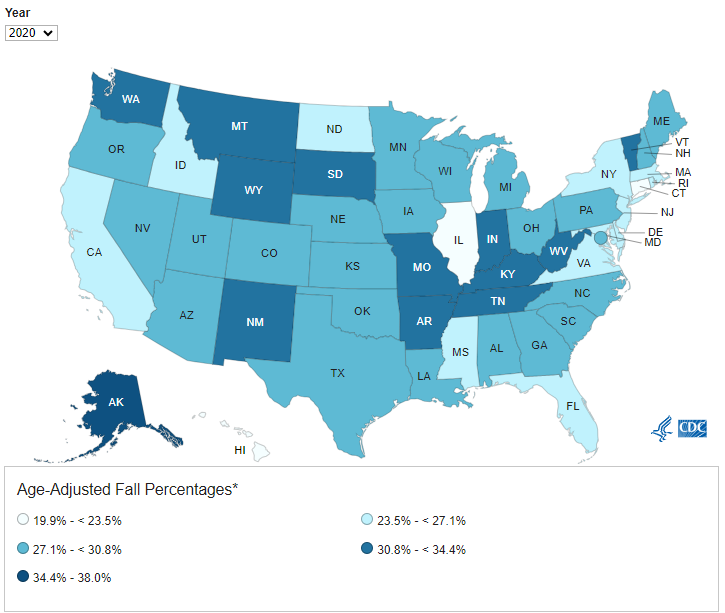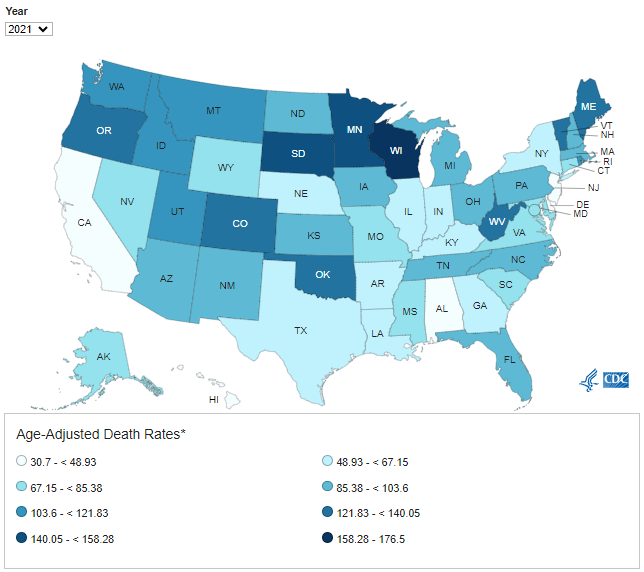
Falls are one of the leading causes of injury among older adults, but they can happen to anyone regardless of age. However, with proper awareness, prevention strategies, and environmental adjustments, the risk of falls can be significantly reduced. In this article, we'll talk about the commonality of falls, their consequences, associated costs, factors that increase fall risk, and practical measures to prevent them.
How Common Are Falls?
Falls among older adults are a significant public health concern. In the United States, more than 14 million adults aged 65 and older, constituting one-quarter of this demographic, experience falls annually. Although not all falls lead to injuries, approximately 37% of those who fall sustain injuries requiring medical attention or causing limitations in their activities for at least one day, resulting in an estimated nine million fall-related injuries. This is based on a CDC 2023 report.
Older Adult Falls Reported by State

source: https://www.cdc.gov/falls/data/index.html
In 2020, for Idaho alone, there were an estimated 75,316 older adults who fell, which accounts for 26.8% of this population.
Consequences of Falls
The consequences of falls can range from minor injuries like bruises and abrasions to more severe outcomes such as fractures, head trauma, and even permanent disability. In addition to physical injuries, falls can also have psychological repercussions, leading to fear of falling, loss of independence, and decreased quality of life.
According to the Centers for Disease Control, one out of five falls resulted in serious injuries like broken bones or head injuries. Annually, 3 million older individuals seek treatment in emergency departments for fall-related injuries, and over 800,000 are hospitalized, often due to head injuries or hip fractures. Hip fractures alone lead to hospitalization for at least 300,000 older adults each year, with more than 95% of these fractures attributed to falling, typically sideways. Hip fractures often result in losing the independence of living at home and require a move to a facility. Not to mention that a broken hip can greatly reduce life expectancy. Falls are also the primary cause of traumatic brain injuries (TBI). And in the worst-case scenario, falls can also lead to death. In 2021, a total of 298 deaths from older adult falls were recorded in Idaho.
Deaths from Older Adult Falls

source: https://www.cdc.gov/falls/data/index.html
Costs Associated with Falls
The economic burden of falls is substantial, encompassing medical expenses, rehabilitation costs, and long-term care. According to the Centers for Disease Control and Prevention (CDC), the total annual medical costs for falls in the United States alone amount to billions of dollars.

Source: https://www.cdc.gov/falls/data/index.html
Taken from the data above, the total annual medical costs for falls in Idaho in 2014 were $164,000,000. Medicare covered $111,000,000, while Medicaid covered $27,000,000, and $26,000,000 was paid privately or out of pocket.
In 2015, the total medical costs associated with falls exceeded $50 billion, with Medicare and Medicaid covering 75% of these expenses.
Factors That Increase Fall Risk
Several factors contribute to an individual's risk of falling, including:
- Biological – Leg weakness, mobility problems, balance problems, poor vision, and chronic health issues (osteoporosis, arthritis, and Parkinson’s disease).
- Behavioral – Psychoactive meds, taking 4 or more different medications, risky behaviors, and inactivity.
- Environmental - Clutter and tripping hazards, no stair railings or grab bars, and poor lighting.
How to Change the Environment to Reduce Fall Risk
Modifying the home environment is crucial for fall prevention. Here are some practical tips:
- Remove tripping hazards such as loose rugs, clutter, and electrical cords.
- Ensure adequate lighting, especially in hallways, staircases, and bathrooms.
- Install grab bars and handrails in key areas like bathrooms and stairways.
- Use non-slip mats in the bathtub and shower.
- Keep commonly used items within easy reach to prevent overreaching and loss of balance.
Devices, Equipment, and Technologies for Fall Prevention
Various devices, equipment, and technologies are available to help prevent falls:
- Mobility aids such as canes, walkers, and wheelchairs provide support and stability.
- Wearable devices like fall detection sensors and personal emergency response systems can alert caregivers or emergency services in the event of a fall.
- Home monitoring systems with motion sensors can detect unusual activity patterns and alert caregivers to potential risks.
- Wheelchair ramps
- Handrails strategically placed to facilitate tasks such as getting in/out of the shower, getting in/out of bed, etc.
- Stairlifts help residents get up and down stairs when navigating stairs poses a hazard
Other Things to Consider
In addition to environmental modifications and assistive devices, other factors to consider for fall prevention include:
- Regular exercise to improve strength, balance, and flexibility.
- Medication management to minimize side effects that may increase fall risk.
- Regular vision check-ups and hearing assessments.
- Consulting with healthcare professionals for comprehensive fall risk assessments and personalized prevention plans.
In-Home Care Services: Integral Support for Fall Prevention
In-home care services play a pivotal role in aiding fall prevention by offering personalized support and implementing targeted interventions to address individual needs. Here are several ways in which in-home care services can contribute to fall prevention:
- Comprehensive Assessments: In-home caregivers conduct thorough assessments of the client's home environment to identify potential fall hazards. These assessments take into account factors such as lighting, flooring, furniture arrangement, and accessibility, allowing caregivers to develop tailored fall prevention plans.
- Environmental Modifications: Caregivers implement necessary modifications to the home environment to minimize fall risks. This may include removing tripping hazards, installing grab bars and handrails in key areas like bathrooms and stairways, and ensuring adequate lighting to improve visibility and safety.
- Assistance with Mobility and Activities of Daily Living (ADLs): In-home caregivers assist with mobility tasks and ADLs, helping clients move safely around their homes. Caregivers may offer support with walking, transferring between surfaces, and using mobility aids such as walkers or canes to enhance stability and prevent falls.
- Medication Management: Caregivers assist clients with medication management to ensure that prescribed medications are taken as directed and that potential side effects that could increase fall risk are identified and addressed. This may involve organizing medication schedules, communicating with healthcare providers, and monitoring for adverse reactions.
- Encouragement of Physical Activity: In-home caregivers encourage and facilitate regular physical activity tailored to the client's abilities and preferences. Engaging in exercises to improve strength, balance, and flexibility can help reduce fall risk by enhancing mobility and stability.
- Fall Detection and Emergency Response: Caregivers may implement fall detection technologies or personal emergency response systems to promptly respond to falls and summon assistance when needed. These devices can provide peace of mind for both clients and their families by ensuring that help is readily available in the event of an emergency.
- Education and Support: In-home caregivers educate clients and their families about fall prevention strategies and provide ongoing support and guidance to promote safety and well-being. This may include teaching clients techniques for fall prevention, educating family members about potential risks, and empowering clients to take an active role in their safety.
By offering personalized support, implementing targeted interventions, and empowering clients to take proactive steps toward fall prevention, in-home care services play a crucial role in promoting safety, independence, and overall well-being for individuals at risk of falls.
Looking for reliable caregivers who can offer personalized support for you or your loved ones? Contact Homewatch CareGivers at 208-350-7269. Homewatch CareGivers of Boise offers personalized and compassionate care designed to meet the specific needs of both your loved one and your family. We strive to simplify the process of finding senior care in Boise, making it hassle-free for you.

